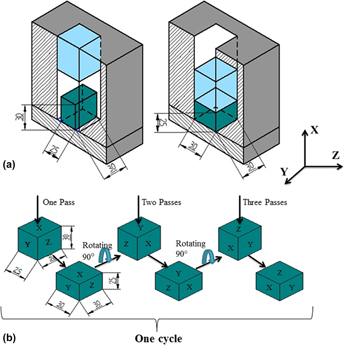Crossref Citations
This article has been cited by the following publications. This list is generated based on data provided by
Crossref.
Sajjan, Sudheer S.
Kulkarni, Mithun V.
Ramesh, S.
Sharath, P. C.
Rajesh, R.
and
Kumar, Vasantha
2019.
Advances in Manufacturing Technology.
p.
131.
Yadav, Prabhat Chand
Sharma, Nitin Kumar
Sahu, Sandeep
and
Shekhar, Shashank
2019.
Influence of short heat-treatment on microstructural and mechanical inhomogeneity of constrained groove pressed Cu-Zn alloy.
Materials Chemistry and Physics,
Vol. 238,
Issue. ,
p.
121912.
Sajjan, Sudheer S.
Kulkarni, Mithun V.
Ramesh, S.
Sharath, P.C.
Sangamesh, Rajole
Kumar, Aravind
and
Rajesh, Rangappa
2019.
Evaluation of Microstructure and Mechanical Properties of Multi Axial Forged LM2 Aluminum Alloy.
Materials Science Forum,
Vol. 969,
Issue. ,
p.
297.
Ramesh, S.
Anne, Gajanan
Nayaka, H. Shivananda
Sahu, Sandeep
and
Ramesh, M.R.
2019.
Investigation of dry sliding wear properties of multi-directional forged Mg–Zn alloys.
Journal of Magnesium and Alloys,
Vol. 7,
Issue. 3,
p.
444.
Ramesh, S.
and
Shivananda Nayaka, H.
2020.
Investigation of Tribological and Corrosion Behavior of Cu-Ti Alloy Processed by Multiaxial Cryoforging.
Journal of Materials Engineering and Performance,
Vol. 29,
Issue. 5,
p.
3287.
K R, Gopi
and
H, Shivananda Nayaka
2020.
Impact of ECAP on wear performance of Al–Mn magnesium alloy.
Materials Research Express,
Vol. 7,
Issue. 1,
p.
016550.
P C, Sharath
2021.
Advanced Welding and Deforming.
p.
529.
Ramesh, S.
Nayaka, H. Shivananda
Anne, Gajanan
Arun, M. N.
and
Naik, Gajanan M.
2022.
Investigation of Tribological Characteristics of Cu-Ti Alloys Processed by Multi-Axial Cryo-Forging.
Metallography, Microstructure, and Analysis,
Vol. 11,
Issue. 3,
p.
537.
Xiong, Feng
Wu, Yuan
Liu, Xiongjun
Wang, Hui
Jiang, Suihe
Zhang, Xiaobin
and
Lu, Zhaoping
2023.
Enhancing cryogenic yield strength and ductility of the Al0.1CoCrFeNi high-entropy alloy by synergistic effect of nanotwins and dislocations.
Scripta Materialia,
Vol. 232,
Issue. ,
p.
115495.
Mohan Raju, S.
Ramesha, C.M.
Anilkumar, T.
Krishna, S.
Appaiah, S.
and
Rajendra, P.
2023.
A Study on Grain Refinement of Aluminum Alloys by Adding Grain Refiners and Severe Plastic Deformation: A Review.
Vol. 1,
Issue. ,
p.
3.
da Silva, Nayara Aparecida Neres
Flausino, Paula Cibely Alves
Aguilar, Maria Teresa Paulino
and
Cetlin, Paulo Roberto
2024.
Comprehensive Materials Processing.
p.
130.
Akbari, F.
Taghiabadi, R.
Yazdi, M. Saghafi
and
Ansarian, I.
2024.
Tribology characteristics of novel Zn–Si alloys severely deformed by multi-directional forging.
Archives of Civil and Mechanical Engineering,
Vol. 24,
Issue. 4,
Xiong, Feng
Liu, Xiongjun
Wang, Hui
Jiang, Suihe
Rempel, Andrey A.
Zhang, Xiaobin
Wu, Yuan
and
Lu, Zhaoping
2024.
Strengthening Al0.1CoCrFeNi high-entropy alloy via multiaxial cryogenic forging and low temperature annealing.
Materialia,
Vol. 34,
Issue. ,
p.
102086.
Hashemizarandi, Saba
Riazat, Amirhosein
Emami, Mohammad
and
Taghiabadi, Reza
2025.
Effect of multi-pass multidirectional forging on microstructure and corrosion behavior of Zn-1Fe biodegradable alloy.
Journal of Alloys and Compounds,
Vol. 1038,
Issue. ,
p.
182810.


